RBA Annual Conference – 2015 Opening Aladdin's Cave: Unpacking the Factors Impacting on Small Businesses Scott Holmes and Dhruba Gupta[*]
1. Overview
For the past four decades, governments, researchers and a broad range of professional associations have focused on the small business sector, primarily from an economic and policy setting perspective. This focus recognises the important role small businesses play in the Australian economy – 97 per cent of businesses, as at June 2014, were classified as ‘small’.[1] However, this classification is based only on employment, which lumps small firms into one homogenous group. In fact, small businesses are mainly unique extensions of their owners' capacities, goals and aspirations. The single classification of ‘small’ does nothing to assist in understanding the complex mix of segments in the small business sector, or the factors that affect these different segments. This paper focuses on unpacking the sector to provide insights into the segments that make up the small business sector in a way that policymakers and other agencies can support and understand.
In Australia, the Wiltshire Report was the first systematic review of the effect of small businesses on the Australian economy and on the factors that influence and affect the sector (Department of Trade and Industry 1971). The Wiltshire Report has been followed by myriad government inquiries and reviews, often with a focus on a single issue, such as: access to finance; regulatory compliance; or succession planning issues for family-owned businesses. There has also been much published research in the academic and professional literature; however, it is constrained by relatively small sample sizes and a focus on single issues rather than on the complex mix of factors that influence the sector. Many of these factors are internal and they often flow from the individuals that own and operate the business; others are external, such as those created by the economy or governments.[2] The outcomes of the cycle of ongoing single-issue inquiries rarely provide a comprehensive understanding of the interrelated multiplicity of factors affecting small business performance.
This paper proposes a novel and comprehensive method for collecting information, focusing on both internal and external factors. The data analysis draws on a representative survey of firms and a new method of data collection. This approach provides a visual map that explains the combination of factors that matter most to business owners, rather than focusing on the elements of a single issue.
The paper identifies five key segments within the small business sector. These segments vary significantly in terms of the factors affecting them and how these factors relate to the aspirations, goals and performance of firms. This information is an important start in moving to a constructive information-based discussion concerning policies directed at removing the impediments identified for each segment of the small business sector.
Importantly, the paper sets out to address not what the small business sector looks like – these data are readily available – but why it is configured in such a way at both the individual firm and macro levels. This information can foster a constructive information-based discussion. This is a uniquely different approach compared with the prevailing single-issue, and often anecdotal, approaches that have occurred to date and provides a platform for an effective alternative policy framework.
The paper proceeds as follows: Section 2 outlines the differences between small businesses and other firms, and explains the importance of adopting the approach taken in this paper for understanding small businesses. Section 3 outlines the survey methodology and data used in the paper. Section 4 outlines the factors that the survey identifies as affecting the small business sector as a whole. Section 5 details the five segments of the small business sector identified by the survey analysis. Section 6 offers concluding remarks.
2. Background
Although almost all modern economies are underpinned by the small business sector, there continues to be very limited information (and therefore limited understanding) of what actually drives and shapes the structure, behaviour and objectives of small to medium-sized enterprises (SMEs). This is because there is a lack of research that acknowledges the differences between large and small businesses. Further, studies of SMEs to date have often focused on single issues – such as SMEs' access to finance. This single-issue approach fails to consider the complex interplay of factors that affect SMEs.
2.1 Small businesses are unique
Small businesses are not ‘scaled-down’ versions of large corporations. While a small business is one whose staff size, financial resources and assets are comparatively limited in scale (Blackburn and Schaper 2012), a crucial qualitative element is that it is independently owned and operated; it is closely controlled by the owners-managers who also contribute most, if not all, of the operating capital; and the principal decision-making functions rest with the owner-managers (ABS 2002, p 1).
In practice, there is normally very little separation of ownership and management in a small business. This fact means that traditional agency relationships do not exist because the owners are almost always the managers. There is often also very limited differentiation between the owner's personal assets and liabilities, and those of the business.
In spite of this difference, there is still a significant gap in the knowledge available to policymakers and regulatory agencies that deal with small businesses. Theoretical explanations of behaviours and subsequent attempts to empirically test such theories tend to be drawn from the mainstream business literature. These theories are often framed by inappropriate assumptions: that small businesses behave in the same way as large ones; that all financing and managerial decisions are made using the same profit-maximising logic as in large businesses; that owner-managers seek to maximise their wealth; and that small businesses predominantly engage in ‘rational optimising’ practices and decision processes. In practice, these assumptions do not hold. Numerous researchers have shown that personal objectives, family considerations, lifestyle factors and personal attributes are often major determinants of small businesses' behaviour (e.g. Holmes et al 2003).
Yet how and why these decisions are made is not well understood by policymakers. For example, despite growing interest in SMEs, there is still no comprehensive understanding of the factors that drive the financial structures of these firms. This lack of understanding is made more difficult by the fact that – unlike large publicly listed firms – performance and related business data are not usually readily available for small businesses.
2.2 Access to finance: one example of being sidetracked by the single-issue approach
Access to finance for the small business sector has been a recurrent theme in the literature and is commonly referred to as having two key components: ‘Knowledge Gap’ and ‘Supply Gap’.[3] It is a regular subject of government review, for example by: the Senate Economics References Committee (Senate Economics References Committee 2010); and the Parliamentary Joint Committee on Corporations and Financial Services (PJCCFS 2013).
The knowledge gap relates to the demand side of SME financing, and refers to the constraints placed on small businesses by the limited knowledge of the owners and operators about funding options. The supply gap relates to the supply side of SME financing and issues that arise in relation to financial institutions and other funders of SMEs, particularly in assessing risk and the overriding preference for asset-based security. Often discussion around the supply side has been in the context of information asymmetries – small business owners know much more about the firm than any other party and public information about a small business' operations is virtually non-existent.
However, it appears that sources of finance are not the major concern for Australian small businesses (Gupta 2013; Institute of Public Accountants 2014).
Rather, many elements influence SMEs' equity and debt funding mix. These include: the owner's objectives; business size; business age; industry sector; levels of business information and security available; and growth stage of the firm. In addition, an owner's personal objectives may override business growth, development and key decisions – particularly in relation to the types of contracts and agreements they enter, including funding arrangements.
The reality is small businesses' behaviour is complex and cannot be summarised by a single issue. Accordingly, there needs to be a fundamental shift away from the narrow focus on single issues. There are many factors that affect a firm's structure – including its financial structure – that interact. Some factors are under the direct control of owners; many are not. The research approach adopted in this paper indicates how a shift away from the single-issue approach and towards a deeper understanding of the factors at play at any point in time for small businesses might be addressed.
3. Method
In order to better understand the interaction and relative importance of the range of factors small business owners confront, a survey of a representative sample of small businesses was undertaken using a new questionnaire format.
3.1 Introducing factor analysis impact maps (FAIM)
3.1.1 Factor maps
The factor analysis impact maps (FAIM) approach is based on the concept that things that matter most should be at the core or centre. Things that matter less are further from the centre. Accordingly, FAIM uses a computerised ‘dartboard’ with a centre or core that is surrounded by 10 concentric circles as part of an online survey questionnaire. Each circle is assigned a number that indicates the distance from the centre.
FAIM begins by displaying a set of potential factors at the outer region of the dartboard that could be affecting a business decision-maker. Each factor is represented by a sphere. The centre of the dartboard represents what is of core concern to the business. Figure 1 shows the FAIM dartboard.
The survey respondent then moves each sphere closer to the centre, depending on how much impact that factor has on their business. As the respondent moves the spheres – either with a cursor or on a touch screen – the distance from the core is shown as a number. Once the sphere is placed in the final position, the number showing the distance to the centre is assigned to the factor. This number is then used for analysis.
Any factors that are perceived to be irrelevant to the business can be placed in a ‘trash bin’ or can be left at zero. Factors left at zero or dropped in the bin are assigned a value of zero for the purposes of analysis.
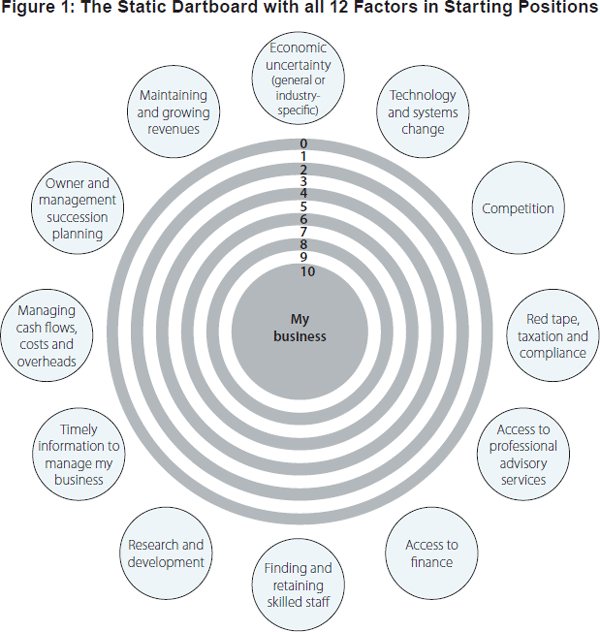
3.1.2 Comparison to traditional methods
FAIM was developed as a simple and intuitive alternative to the traditional rating scales used by survey researchers that can be repetitive and tedious for respondents. Moreover, traditional methods are associated with several response biases that can undermine data quality.[4]
The FAIM approach has been thoroughly validated and compared with traditional market research scales in a separate study of more than 3,000 subjects (Blamey and Holmes 2014). Compared with traditional rating scales, FAIM:
- produced more thoughtful responses, with respondents spending more time on each decision and results showing better discrimination among concepts
- produced a much lower proportion of respondents giving the same answer to every item in a set – a phenomenon known as ‘straight-lining’
- was the preferred questionnaire format among respondents
- elicited a richer variety of information.
FAIM provides a more meaningful, enjoyable and engaging format for respondents, thereby increasing motivation to respond carefully. It also makes it more difficult for respondents to provide careless answers.
3.1.3 Application of FAIM in this study
The FAIM approach was applied in this study to help understand:
- the extent to which small business decision-makers were affected by a single factor or a multitude of factors
- which factor or factors were having the greatest effect on the small business sector overall
- whether different factors affected different members of the small business sector in different ways.
The survey focused on the effect of 12 different factors among small businesses. These factors were identified by an online search of the factors associated with the small business sector, an internal analysis of small business reporting in the mainstream media, and feedback from the NSW Business Chamber. The 12 factors that were chosen are presented in Figure 1.
3.2 Survey methodology
To determine the factors that affect small businesses, a total of 1,001 online interviews were conducted nationally in February 2015.[5] Firms were sourced through the QOR online access panel.[6]
A stratified sample was drawn with the target distribution of responses aligned to the Australian Bureau of Statistics (ABS) business sample profile on variables including state/territory and number of employees.[7] Respondents were typically the most senior decision-makers within the firms, usually business owners, chief executive officers or managing directors. Weighting by states and number of employees was undertaken to ensure that the survey data represent the business population as defined by the ABS.
The survey questionnaire included a range of background questions concerning the characteristics and performance of the firm. Respondents were also asked about their firm's objectives for the coming year, with a focus on business growth. Following those qualitative questions, the FAIM methodology was used to measure how business decision-makers assessed the relative effect of the 12 factors. Respondents were asked to indicate the effect each of the 12 factors had had on their firms over the last twelve months on the FAIM scale from 0 to 10 – where 0 means ‘No influence/impact at all’ and 10 means ‘Extremely high influence/impact’.
Additional questions were also asked for several factors to assess the relative effect of the sub-elements that make up that factor.
4. Results – Unpacking the Factors
4.1 Small business overall
Figure 2 clearly shows that no single issue affects all firms. However, five out of the twelve issues have more of an effect than the others, namely:
- maintaining and growing revenues
- economic uncertainty
- managing cash flows, costs and overheads
- competition
- red tape, taxation and compliance.
The top five issues represent a mix of internal and external factors, but they appear to be predominantly beyond the direct control of owner-managers, perhaps with the exception of cash flow, cost and overhead management.
There is further evidence that it isn't a single issue that is perceived by owners to be affecting their business: 71 per cent of businesses reported effects of 6 or higher on at least two factors, and 56 per cent on at least three factors. This has direct implications for support, information, training and policy aimed at the small business sector.
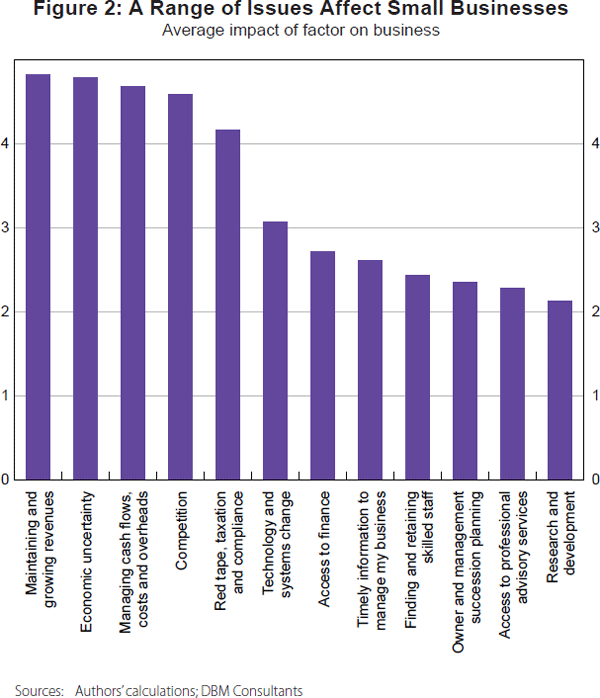
4.2 Unpacking the sub-factors
Further insight into the factors affecting small business emerged from an analysis of the sub-factors that respondents indicated lay behind five factors affecting their business. Results indicated that:
- Tax compliance accounts for a third of all the red tape, taxation and compliance items.
- Competition from other small businesses appears to be the biggest sub-factor within the competition factor. This is consistent with ABS data, which found that 54 per cent of small businesses have other small businesses as their major competitors.
- General economic conditions – such as consumer confidence – account for nearly two-thirds of all economic uncertainty.
- Keeping up with technology accounts for a third of the research and development factor.
- Finding staff seems to be the most important sub-factor of finding and retaining skilled staff.
Appendix B has further details on the sub-factor results.
5. Segmentation of Small Business
Given the diversity of small businesses in terms of industry, turnover, age, and goals and aspirations, it would be expected that different issues affect different firms differently. To determine how small businesses vary in the issues that affect them, a segmentation analysis was performed.[8] The analysis revealed five distinct segments:
- financially constrained growth-aspirers (GA)
- externally impacted growth-seekers (GS)
- broadly impacted stability-seekers (BISS)
- stress-free stability-seekers (SFSS)
- technology-oriented growth-achievers (TOGA).
Each of these segments is summarised below. Figure 3 shows the size of each of the segments.
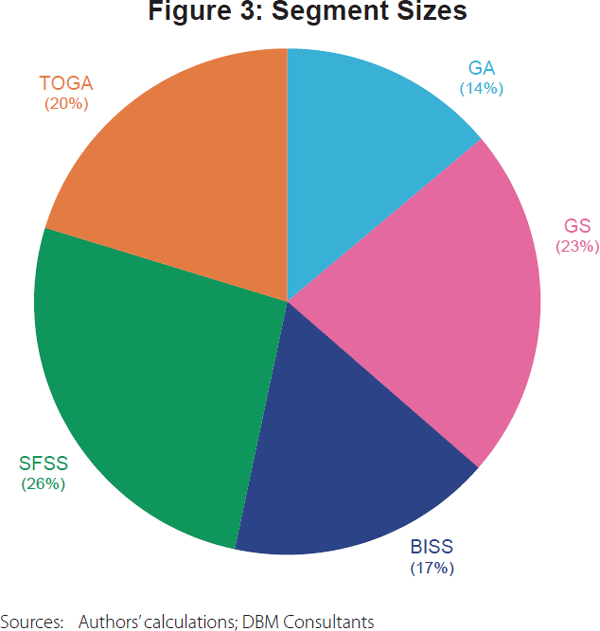
5.1 Financially constrained growth-aspirers (GA)
Businesses in the GA segment are younger businesses mostly seeking growth but struggling to achieve it. Two-thirds had not performed to expectations over the past 12 months and less than half were satisfied with their performance.
The main factors impeding growth are presented in Figure 4. The primary distinguishing factors for this segment are: access to finance; managing cash flows, costs and overheads; and maintaining and growing revenues.
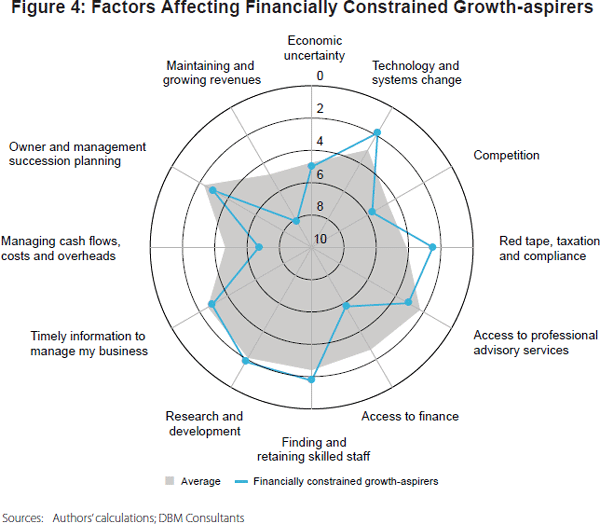
5.2 Externally impacted growth-seekers (GS)
The GS segment comprises mature businesses mostly seeking growth and, like the GA segment, struggling to achieve it. Within the GS segment, 65 per cent of firms surveyed performed worse than expected over the past 12 months, and less than half were satisfied with their firm's performance.
These firms believe they are being held back by largely external factors such as general economic uncertainty and strong competition from other small and larger businesses, including online and offshore (Figure 5). In contrast to the GA segment, access to finance is not seen as a major constraint on growth; however, taxation compliance is.
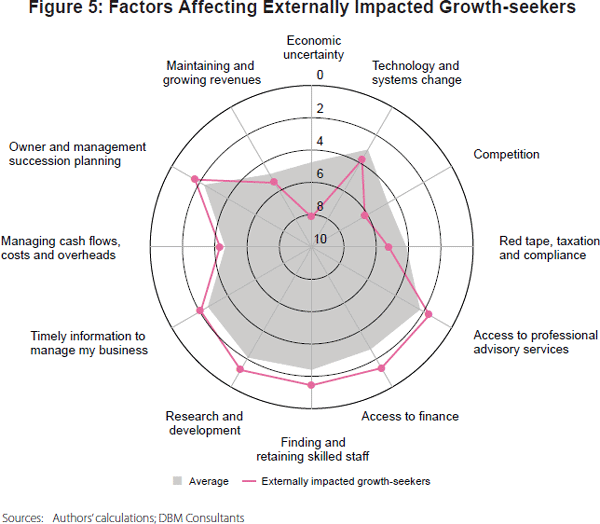
5.3 Broadly impacted stability-seekers (BISS)
Firms in the BISS segment have relatively lower growth aspirations when compared with the GA and GS segments; yet these firms are only moderately satisfied with their performance. With almost half reporting that their firm performed worse than expected, firms in the BISS segment report a range of factors that they believe are responsible (Figure 6). Managing finances features quite prominently among the impact factors, such as managing cash flows, costs and overheads, taxation and compliance, and access to finance. Finding good staff was also reported as affecting many businesses in this segment. Economic uncertainty was also reported as playing a role.
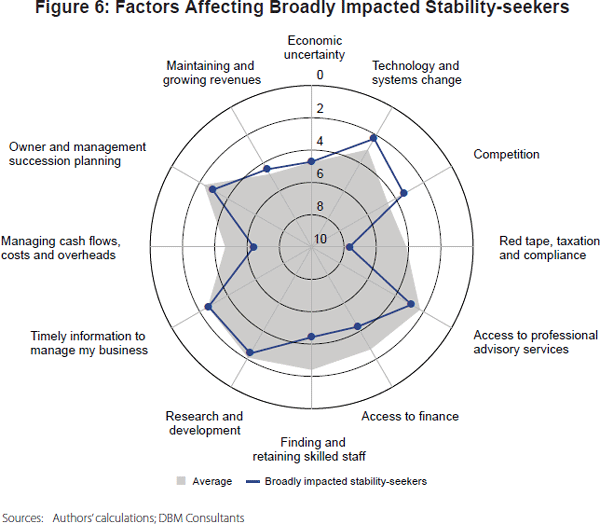
5.4 Stress-free stability-seekers (SFSS)
The SFSS segment is firms that are mostly seeking stability of revenues. Firms in the segment are generally comfortable with the way the firm is operating and the resulting outcomes. More than 70 per cent are satisfied with the firm's ability to meet their goals and the incidence of moderate and high concern about business prospects for the next year is the lowest of any segment.
Not surprisingly, firms in this segment do not report large effects from any of the factors; all impact factors received below-average scores (Figure 7). While some of the factors may simply not be applicable to many of the firms in this segment, the broad industry profile suggests that other reasons must be at play. Many are likely to have accepted that certain factors such as red tape are just a necessary part of doing business, or have learnt how to minimise or avoid excessive impacts.
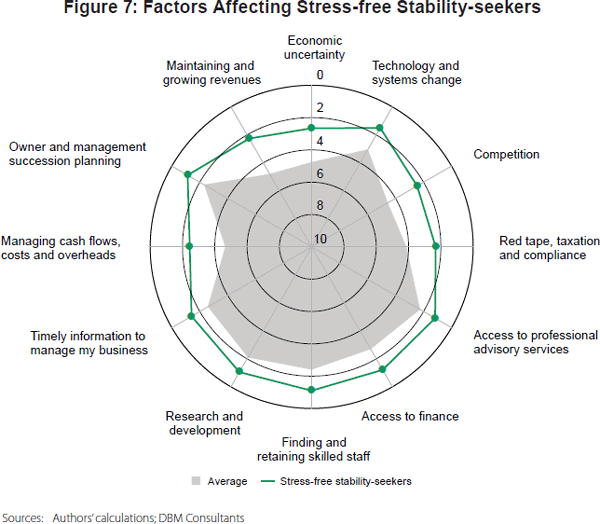
5.5 Technology-oriented growth-achievers (TOGA)
Firms in the TOGA segment tend to be relatively larger and involved in the production of technology-related products and services. Most of these growth-oriented businesses are successful in achieving their goals, with the proportion reporting that they performed better than expected far higher than the proportion that reported they performed worse than expected.
Despite being the most satisfied of all segments on average, firms in this segment still report a range of constraints (Figure 8). Indeed, they report the highest average level of effects from technology and systems change, research and development, access to professional advisory services, timely information to help manage the business, and owner and succession planning. Although not uniquely associated with this segment, competition, maintaining and growing revenues and managing cash flows, costs and overheads also significantly affect these firms.
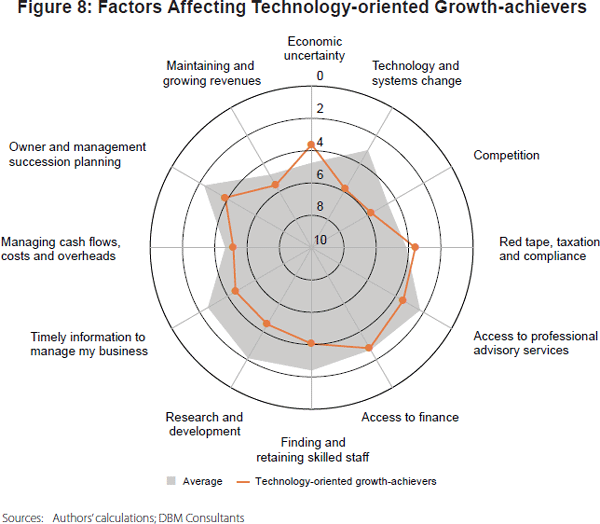
A more detailed summary of the key themes and profiles for all five segments of the small business sector is provided in Appendix A.
6. Conclusions and Next Steps
This paper had a very clear objective: to understand the mix of factors that affect small businesses and to move away from the assumption that small businesses are simply those with fewer than 20 employees.
It is obvious that the small business sector includes a diverse set of firms. Each of the five segments identified will naturally include sub-segments and this will be the focus of future analysis and research. These segments are intrinsically linked to the aspirations and subsequent performance of the firms. This performance is, in turn, linked to the factors that owner-managers in each segment perceive as affecting the achievement of their aspirations. It is interesting how different the segments are with respect to the underlying business objectives and performance, and also the difference in impact factors.
In terms of methodology, the FAIM approach allows for a comparatively more robust and representative set of responses concerning the range of factors perceived to be affecting small businesses. The diversity among small businesses revealed by this research suggests that the homogenous approach adopted by much of the literature may overlook key factors. For instance, surveying all manufacturing firms with fewer than 20 employees would tell us little about the diversity of motivations in such a sample.
The FAIM approach provides a platform from which we can finally understand the qualitative story of a sector with almost 2 million business entities. It will also allow for a more developed dialogue with business owners at many levels – from advisory services to policy development. It can inform areas such as supporting growth objectives and addressing the impediments to growth, rather than seeking to pare issues down to single factors, such as access to finance.[9] Policies and programs designed to support or inform business owners need to be informed by the differences among small businesses. Accordingly, any initiatives or policies to address particular issues need to be clearly linked to the target group. Hopefully, future inquiries and reviews will take on board the complex and integrated nature of the issues that affect small businesses, rather than over-simplifying issues to allow for the conduct of an inquiry or review.
One additional and important aspect of the method adopted here is that it allows for a comprehensive longitudinal study of these issues at both the individual business and segment level. Future study can address questions like: what happens when external factors change? what are the effects of policies that are targeted at particular segments? and how do aspirations shift over time? Using the methodology in this paper, a revealing story about this complex and almost enigmatic foundation of the Australian economy can finally be told.
Footnotes
The authors are from the University of Western Sydney and DBM Consultants, respectively. The authors would like to acknowledge Brian Fine at the QOR online access panel company, Luke Aitken from the NSW Business Chamber, and Dr Russell Blamey, Dr Dieu Anh Vu and David Claridad from DBM Consultants for their contributions. [*]
Small is defined, in this case, as less than 20 employees (ABS Cat No 8165.0 ‘Counts of Australian Businesses, Including Entries and Exits’). [1]
For example, the compliance costs of regulations, interest rates and exchange rates. [2]
A detailed summary of these issues can be found at Holmes et al (2003). [3]
For example, when several statements are rated one after the other, results often exhibit a significant degree of ‘straight-lining’ behaviour in which the same answer is given for every item as an easy way of ‘satisficing’ and getting through the survey quickly (Schaeffer and Presser 2003; Cole, McCormick and Gonyea 2012). Another problem that commonly plagues rating-scale data is the occurrence of ‘halo’ responses in which respondents' answers are influenced more by their general attitudes to the broad topic than the specifics of the items being rated (Krosnick 1999). This can result in data which does not exhibit the level of discrimination between concepts that researchers intended. [4]
The survey questionnaire is available online at <http://fivetribes.dbmweb.com.au>. [5]
Quality Online Research (QOR) is one of Australia's leading online panel providers for business samples. The small business panel includes a cross-section of more than 10,000 firms, with firms recruited primarily from offline sources to avoid online bias. QOR is accredited with ISO 26362 and QSOAP Gold, reflecting the high quality standards used. [6]
ABS Cat No 8165.0 ‘Counts of Australian Businesses, Including Entries and Exits, June 2010 to June 2014’. [7]
K-means cluster analysis was used in deriving the segments, with the identification of key impact factors distinguishing each segment from others being based on t-tests for differences in means. The p-values were adjusted to take account of multiple comparisons (Bonferroni method). [8]
Which, interestingly, didn't make the top five impact factors in the full sample. [9]
Appendix A: Segment Profiles
| Financially constrained growth-aspirers (GA) | Externally impacted growth-seekers (GS) | Broadly impacted stability-seekers (BISS) | Stress-free stability-seekers (SFSS) | Technology-oriented growth-achievers (TOGA) | |
|---|---|---|---|---|---|
| Segment size – per cent of sample | 14 | 23 | 17 | 26 | 20 |
| Business characteristics | Highest proportion of sole or majority shareholder Average number of employees (90% less than four); revenues slightly below average Skewed towards younger businesses (44% three years or less in operation) Broad range of industries with slight skew towards certain services such as ‘Other services’ Businesses valued below average (58% predict sale price less than $20,000) 41% in NSW/ACT |
Average size in terms of employees and revenues Mostly mature businesses, with 48% having been in operation for more than ten years Broad industry profile Businesses valued about average 32% in NSW/ACT |
Slightly larger than average based on revenue (48% less than $100,000)
but not employees Less likely to be a start-up with less than one year in operation Broad industry profile Relatively high expected sale price 31% in Vic/Tas |
Smaller than average based on revenue (71% less than $100,000), employee
numbers only marginally lower Years in operation about average Broad industry profile Average expected sale price 37% in NSW/ACT |
Largest businesses in terms of both revenue and number of employees Years in operation about average Broad industry profile with slight skew towards ‘Professional, scientific and technical services’ Slightly more likely to be involved in importing or exporting Relatively high expected sale price 36% in NSW/ACT |
| Goals | Most strongly growth-oriented of all the segments (approximately two-thirds seeking growth) | Average growth orientation (55% seeking growth) | Majority seeking to remain stable (60%) | Majority seeking stability (61%), with lowest proportion of any segment seeking growth (36%) | Growth-oriented (second highest together with GA) |
| Performance | Despite this growth orientation, less than 40% actually experienced an
increase in prior 12 months Majority (two-thirds) reported that the business performed worse than expected over last 12 months; only 45% satisfied that business allowing them to meet their goals 92% express some concern about prospects for achieving goals over the next year, with 50% of businesses expressing moderate to high levels of concern |
Less than 40% actually experienced growth over last 12 months, with a
quarter experiencing decreased revenues 64% reported the business performed worse than expected (second highest behind GA); just under half were satisfied 83% remain concerned with prospects over next 12 months, of which 43% express moderate or high concern |
Actual revenue experiences over last 12 months are about average, with
45% increasing and 38% remaining stable Just under half report that their business performed worse than expected Moderate levels of satisfaction with business' ability to meet goals Concern about prospects for next 12 months slightly below average |
Just under half actually experienced stability in revenues over the last
12 months, with 37% achieving increases Most likely to expect revenues next 12 months to be similar to last 12 months Similar proportion report that performance over last 12 months was better than expected/worse than expected (41%/37%) Generally satisfied with business' ability to meet goals (71% satisfied, of which 32% highly satisfied) Lowest incidence of moderate and high concern about business prospects of any segment(16%) |
Most likely of all segments to have experienced increased revenues over
last 12 months (56%) Most likely to report that performance was better than expected over last 12 months and far less likely to report it as worse than expected Most highly satisfied of all segments Most optimistic about performance over next 12 months, however, concerns about prospects over next year are average |
| Factors affecting business |
Key factors
Other factors
|
Key factors
Other factors
|
Key factors
Other factors
|
All factors have below average perceived impact, businesses in this segment
are relatively unconcerned about constraints They are comfortable with the way the business is operating and business outcomes |
Key factors
Other factors
|
Appendix B: Sub-factor Analysis
| Red tape, taxation and compliance | Industrial relations (IR)/human resources, (HR) work health and safety (WHS) | Local government | Tax compliance | ASIC and corporate regulation | Payroll and state reporting | Other/none of these |
|---|---|---|---|---|---|---|
| 18% | 16% | 33% | 15% | 8% | 10% | |
| Competition | From larger businesses | From other small businesses | From online businesses | From offshore businesses | Other/none of these | |
| 28% | 42% | 18% | 8% | 4% | ||
| Economic uncertainty | General (consumer confidence, business confidence, inflation, interest rates etc) | Technology, changes to tax concessions, uncertainty of changes | Other/none of these | |||
| 66% | 24% | 10% | ||||
| Research and development | Technology, systems or e-commerce | Keeping up with technology | Using technology to differentiate, innovate or otherwise get an advantage over the competition | Other/none of these | ||
| 19% | 35% | 28% | 19% | |||
| Finding and retaining skilled staff | Finding staff | Training staff | Retaining staff | Other/none of these | ||
| 34% | 23% | 25% | 18% |
References
ABS (Australian Bureau of Statistics) (2002), ‘Small Business in Australia, 2001’, ABS Cat No 1321.0.
Blackburn RA and MT Schaper (eds) (2012), Government, SMEs and Entrepreneurship Development: Policy, Practice and Challenges, Gower, Farnham.
Blamey R and S Holmes (2014), ‘Putting Yourself at the Centre: Testing a New Online Task Format’, Presented at the Australian Market & Social Research Society Conference, Melbourne, 4–5 September.
Cole JS, AC McCormick and RM Gonyea (2012), ‘Respondent Use of Straight-Lining as a Response Strategy in Education Survey Research: Prevalence and Implications’, Roundtable presentation at the Annual Meeting of the American Educational Research Association ‘Non Satis Scire: To Know Is Not Enough’, Vancouver, 13–17 April.
Department of Trade and Industry (Department of Trade and Industry and Advisory Committee on Small Business) (1971), Report of the Committee on Small Business, (FM Wiltshire, Chair), Department of Trade and Industry, Canberra.
Gupta D (2013), ‘Australian Small Business: Facts and Figures’, Paper presented at the NAB National Small Business Summit hosted by the Council of Small Business of Australia (COSBOA), Canberra, 24–25 July.
Holmes S, P Hutchinson, D Forsaith, B Gibson and R McMahon (2003), Small Enterprise Finance, John Wiley & Sons Inc, Milton.
Institute of Public Accountants (2014), ‘Australian Small Business White Paper Summit’. Available at <http://www.publicaccountants.org.au/resources/small-business-white-paper>.
Krosnick JA (1999), ‘Survey Research’, Annual Review of Psychology, 50, pp 537–567.
PJCCFS (Parliamentary Joint Committee on Corporations and Financial Services) (2013), Family Businesses in Australia – Different and Significant: Why they Shouldn't be Overlooked, (D O'Neill, Chair), Commonwealth of Australia, Canberra.
Schaeffer NC and S Presser (2003), ‘The Science of Asking Questions’, Annual Review of Sociology, 29, pp 65–88.
Senate Economics References Committee (2010), Access of Small Businesses to Finance, (A Eggleston, Chair), Commonwealth of Australia, Canberra.